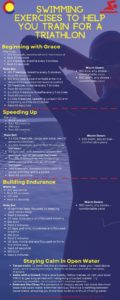New triathletes view the swimming leg of their races with apprehension. It makes sense — more than half the population reports being unable to swim unassisted.
Swimming long distances require endurance that must be built up over a long period of time. You need skills, including breath control, stroke technique, and the ability to pace yourself.
The swim leg of an Olympic triathlon spans nearly a mile. If you train in a 25-yard pool, that means swimming nonstop for 34 laps. Fortunately, there are tried and true exercises to take you from shivering in your wetsuit to hopping on your bike smoothly. The following work best if you commit to entering the water 2 to 3 times each week leading up to your race for at least six weeks.
Beginning with Grace
For a triathlon, most competitors find a modified freestyle to be the best stroke for going the distance and keeping track of path markers. Take time to watch a few freestyle stroke lessons like this one to get a sense of the best techniques.
A poor technique can slow one down considerably. For instance, an untrained arm pull can make you lose propulsion. This workout emphasizes controlled strokes and steady breathing patterns.
Warm Up
- 200 Freestyle, breathe when it feels natural
- Rest 30 seconds
- 200 Freestyle, breathe every 3 strokes
- Rest 60 seconds
Main Set
- 100 Freestyle, breathe every 5 strokes
- Rest 30 seconds
- 100 kick (use a board or hold arms in a streamlined position between breaths)
- 50 Freestyle, breathe every 7 strokes
- Rest 30 seconds
- 2 x 200s Freestyle, breathe every 5 strokes
- Rest 60 seconds
- 5 x 50s Freestyle, speeding up each 50 and breathing as little as possible
- Rest 60 seconds
Warm Down
- 100 kick, any stroke – comfortable pace
- 300 swim, any stroke – comfortable pace
Speeding Up
Once you feel comfortable with your stroke technique, start tracking your speed. How fast can you finish a 50? What happens to your form as you speed up? If you find yourself out of breath, don’t push forward. Instead, take a break, stretch, or do a kick set. Then, reprioritize breathing and good form as you speed up again.
Warm Up
- 300 Freestyle
- Rest 30 seconds
- 200 kick
- Rest 60 seconds
Main Set
- 5 x 50s Freestyle, moderate pace, rest 10 seconds between
- 5 x 50s Freestyle sprint, rest 15 seconds between
- 5 x 50s kick, with board or streamline position, rest 10 seconds between
- 2 x 100s Freestyle sprint, breathing consistently and rest 30 seconds between
- 200 Freestyle, increase pace each 25 yards until the last is a sprint
- Rest 60 seconds
Warm Down
- 200 swim, any stroke – comfortable pace
Building Endurance
Unless you latch onto a buoy or call for assistance, there are no breaks during the triathlon’s swim leg. It’s crucial to practice going the distance during your workouts. It might feel tedious to complete 34 or more laps without stopping, but you’ll be grateful on race day. To pass the time during this endurance exercise, try singing songs, planning your next meal, or modifying your stroke and pace to track any changes in your overall times or exhaustion level.
Some athletes prefer to save their legs for triathlon biking and running stretches. To practice this, consider making some of the following sets into pull only.
Warm Up
- 300 any stroke
- Rest 30 seconds
- 100 kick
- Rest 60 seconds
Main Set (All Freestyle)
- 10 sprinted laps, focused on keeping your stroke long
- Rest 2 minutes
- 20 laps, slow pace and focused breaths
- 100 kick
- Rest 2 minutes
- 20 laps, pull only, moderate and focused breaths
- 100 kick
- Rest 2 minutes
- 40 laps, moderate and focused on form the entire way
- Rest 60 seconds
- 100 kick
- Rest 2 minutes
Warm Down
- 300 swim, any stroke – comfortable pace
Staying Calm in Open Water
Open waters are very different environments than a controlled pool — from choppy waters to shallow seabeds and the crush of other swimmers. Being kicked mid-stroke can throw anyone off their game.
If possible, plan trips to where your race is being held. Get familiar with the water’s temperature, turbidity, and visibility levels. Here are three tips for maintaining a solid stroke and pace in uncertain waters:
- Tarzan swim: To swim like the animated Tarzan, keep your head above water while moving freestyle. Hone in on buoys and other distance markers.
- Swim with a Crowd: Find a lane buddy, fellow trainee, or visit your local YMCA to get acquainted with navigating crowded waters. Try swimming shoulder-to-shoulder with another person.
Embrace the Chop: The presence of choppy waves can make the most seasoned open-water swimmer nervous. Practice breathing between wave crests, ensuring you know how to do so without inhaling water.








